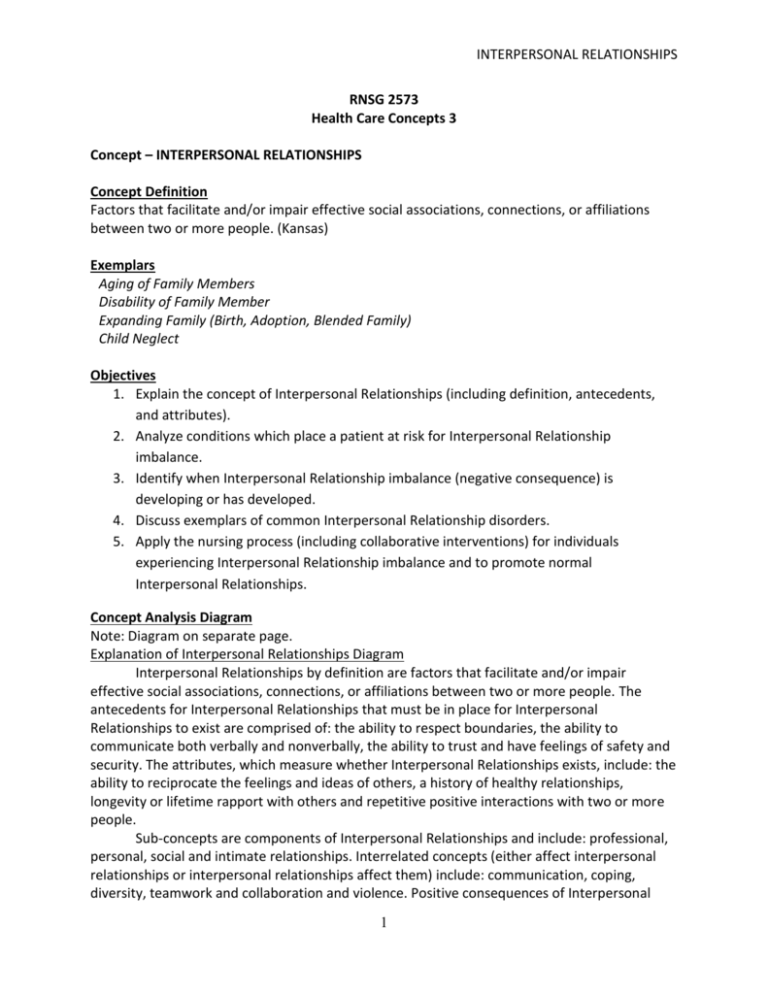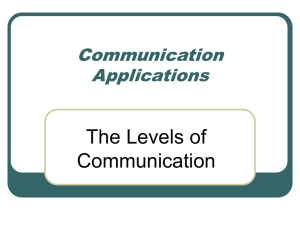Interpersonal Relationships - Trinity Valley Community College
advertisement

INTERPERSONAL RELATIONSHIPS RNSG 2573 Health Care Concepts 3 Concept – INTERPERSONAL RELATIONSHIPS Concept Definition Factors that facilitate and/or impair effective social associations, connections, or affiliations between two or more people. (Kansas) Exemplars Aging of Family Members Disability of Family Member Expanding Family (Birth, Adoption, Blended Family) Child Neglect Objectives 1. Explain the concept of Interpersonal Relationships (including definition, antecedents, and attributes). 2. Analyze conditions which place a patient at risk for Interpersonal Relationship imbalance. 3. Identify when Interpersonal Relationship imbalance (negative consequence) is developing or has developed. 4. Discuss exemplars of common Interpersonal Relationship disorders. 5. Apply the nursing process (including collaborative interventions) for individuals experiencing Interpersonal Relationship imbalance and to promote normal Interpersonal Relationships. Concept Analysis Diagram Note: Diagram on separate page. Explanation of Interpersonal Relationships Diagram Interpersonal Relationships by definition are factors that facilitate and/or impair effective social associations, connections, or affiliations between two or more people. The antecedents for Interpersonal Relationships that must be in place for Interpersonal Relationships to exist are comprised of: the ability to respect boundaries, the ability to communicate both verbally and nonverbally, the ability to trust and have feelings of safety and security. The attributes, which measure whether Interpersonal Relationships exists, include: the ability to reciprocate the feelings and ideas of others, a history of healthy relationships, longevity or lifetime rapport with others and repetitive positive interactions with two or more people. Sub-concepts are components of Interpersonal Relationships and include: professional, personal, social and intimate relationships. Interrelated concepts (either affect interpersonal relationships or interpersonal relationships affect them) include: communication, coping, diversity, teamwork and collaboration and violence. Positive consequences of Interpersonal 1 INTERPERSONAL RELATIONSHIPS Relationships may include things such as: forming a social network, personal growth and flexibility and developing security and trust. Negative consequences of mal-adaptive Interpersonal Relationships include things such as: co-dependence, mistrust, insecurity, inability to work with others, isolation and becoming rigid and inflexible. Nursing care is implemented either proactively or in response to negative consequences and is focused on improving the antecedents. If the nursing care is successful the result will be the measurement of optimal attributes which will indicate Interpersonal Relationships exists. Assignments Prior to class: 1. Review the following from previous course(s) From general Psychology Interpersonal Relationships and Therapeutic and Nontherapeutic Communication Techniques 2. Prior to class Review the Reading/Viewings section below 3. Review the following Nursing Diagnoses Impaired social interaction Decisional conflict Ineffective role performance Powerlessness Low self-esteem (chronic; situational) Ineffective coping 4. Readings/Viewing References: to be assigned by instructor Content Outline Concept: Interpersonal Relationships 1. 2. 3. 4. Interpersonal Relationships Defined Sub-concepts/components of Interpersonal Relationships. (see template below) Antecedents for Interpersonal Relationships. (see template below) At Risk and risk factors related to Interpersonal Relationship Imbalance (see template below) a. Health continuum (best/worst) b. Age continuum (young/old) c. Environment d. Personal – natural, biological, psychological, cultural, behavioral, social] 5. Assessment for balance/imbalance (including Diagnostic tests) a. Personality Assessments (ie. Myers Briggs) 6. Nursing Diagnoses b. Impaired social interaction c. Decisional conflict d. Ineffective role performance 2 INTERPERSONAL RELATIONSHIPS e. Powerlessness f. Low self-esteem (chronic; situational) g. Ineffective coping 7. Outcomes/Nursing Care 8. Exemplars (demonstrate nursing process and interrelated concepts) 3 INTERPERSONAL RELATIONSHIPS Concept Analysis Diagram – INTERPERSONAL RELATIONSHIPS Nursing Care Directed toward what contributes to a normal concept and is thereby related to all factors involved in or with the concept. Not always needed to have a normal outcome. Attributes Defining characteristics of the concept What must occur for the concept to exist Antecedents What precedes the concept for it to exist Events or incidents that must happen before the concept Consequences Untoward events or outcomes that occur due to malfunction within the concept Positive events or outcomes that occur due to proper functioning within the concept Interrelated Concept Concepts which can affect change in the other Concepts which work together to ensure a normal process Concepts which if depleted or impaired can cause a negative consequence in the other Sub- Concept Critical components of major concept Attributes Coping Ability to Reciprocate the Feelings and Ideas of Others History of Healthy Relationships Longevity (Lifetime Rapport) Repetitive Positive Interactions with 2 or More People Nursing Care Communication Diversity Teamwork & Collaboration Interrelated Concepts Antecedents Ability to Trust Feelings of Safety/Security Ability to Respect Boundaries Ability to Communicate (verbal/nonverbal) Interpersonal Relationships: Factors that Facilitate and/or Impair Effective Social Associations, Connections, orAffiliations Between Two or More People. (Kansas) Consequences (Outcomes) Co-dependence Negative (Unhealthy) Sub Concepts Professional Personal Positive (Healthy) Security/Trust Social Intimate Mistrust Insecurity Rigid/Inflexible Isolation Social Network Development/Flexibility 4 Inability to Work with Others







